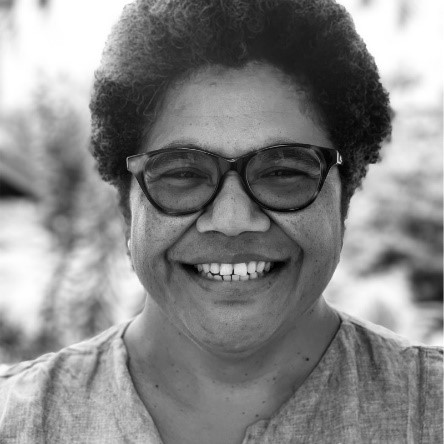Ms. Litea Biukoto and Mr. Kaliopate Tavola, The Pacific Community (SPC)
The Pacific Community (SPC) is a longtime member of Sentinel Asia, originally having joined as South Pacific Applied Geoscience Commission (SOPAC), which is now the Geoscience, Energy and Maritime Division (GEM) of SPC. SPC has 27 member countries and territories in the Pacific region. They support their members in the event of disasters as Sentinel Asia’s Joint Project Team (JPT) member as well as its Data Analysis Node (DAN), including sending Emergency Observation Requests (EORs).
The Sentinel Asia Secretariat interviewed Ms. Litea Biukoto and Mr. Kaliopate Tavola to introduce their contribution to the area and to Sentinel Asia.
 |
 |
| Ms. Litea Biukoto |
Mr. Kaliopate Tavola |
Sentinel Asia Secretariat
SPC has participated in Sentinel Asia since the very beginning. Can you introduce your organization and activities for our readers?
SPC
SPC is the principal scientific and technical organization in the Pacific region, proudly supporting development since 1947. We are an international development organization owned and governed by our 27 country and territory members, 5 of them metropolitan countries. SPC works across key sectors through its technical divisions – Climate Change and Environmental Sustainability; Educational Quality and Assessment; Fisheries, Aquaculture & Marine Ecosystems; Geoscience, Energy and Maritime; Human Rights and Social Development; Land Resources; Public Health; and Statistics for Development.
SPC, through its Geoscience, Energy and Maritime, coordinates regional disaster risk management activities in the Pacific: https://gem.spc.int/key-work/DCRP.
Sentinel Asia Secretariat
Could you also introduce the framework whereby SPC shares information on disasters with the Pacific countries and your cooperation with these countries in emergency response, including in the case of Sentinel Asia’s Emergency Observation Requests (EORs)?
SPC
SPC convenes the annual Regional Disaster Managers Meeting to facilitate the coordination of disaster risk management activities in the Pacific, including providing policy guidance, information sharing, and identifying future direction for resourcing.
Areas where we work with the National Disaster Management Offices and other government agencies:
- Early warning and preparedness
- Recovery planning, particularly with Post-Disaster Needs Assessments
- Risk assessments – exposure mapping. Post-disaster technical assessments, information management.
- Training and capacity development – design and delivery of accredited and non-accredited training, workshops. Supporting peer-to-peer exchanges, conducting exercises and drills.
- Resource mobilization
Sentinel Asia Secretariat
Regarding the past Emergency Observation Requests (EORs) from SPC and SOPAC, could you tell us the memorable cases and how the data from Sentinel Asia was used in those cases?
SPC
Tropical Cyclone Harold in April 2020. The cyclone passed through Fiji and Vanuatu during a time when COVID-19 travel restrictions were in place. As with other activations in the Pacific, the images captured and the information products delivered were the first impressions of areas affected and the extent of impact. While the government through the National Disaster Management Office was planning its efforts, we were able to have initial discussions with UNDP (United Nations Development Program) and the Department of Strategic Policy, Planning and Aid Coordination on the need for a PDNA (Post-Disaster Needs Assessment).
Sentinel Asia Secretariat
In Pacific countries, the main targets of Earth observation are floods caused by storms, and volcanic eruptions, we suppose, along with your EORs. Could you tell us what satellite data and value-added-products are useful for your activities?
SPC
We would like to have more high-resolution satellite data for building footprint extraction to inform some of the work we do around exposure mapping and asset modelling.
The challenge with using visible imagery immediately after weather-related events is cloud cover. Satellite imagery acquired sometime after an event is also useful as the effect ‘footprint’ is still quite visible.
The geographic footprint of a disaster is useful particularly when trying to gauge the extent of impact. In the case of tropical cyclones, though the response effort is often prioritized near the track, areas that are also affected by rain and flooding are potentially farther away. Ensuring that these areas are adequately serviced can be assisted with the provision of maps showing areas affected.
Sentinel Asia Secretariat
Does anything stand out as memorable in your experience with Sentinel Asia activities?
SPC
The Secretariat has reached out to check if an activation is needed when requests are not forthcoming. I’ve also found the Secretariat to be very responsive when requests are submitted.
Sentinel Asia Secretariat
What do you think of the merits of Sentinel Asia, for example, image processing by DAN in a timely manner?
SPC
The timely image processing is valuable. Requests can be made with relative ease.
Sentinel Asia Secretariat
At JPTM 2023 held in this September, you introduced your activities including the Digital Earth Pacific project and capacity building program. Do you have any programs that can be shared with Sentinel Asia members?
SPC
The Digital Earth Pacific (DEP) aims to simplify the utilization and accessibility of decades’ worth of satellite data, enabling decision-makers throughout the Pacific region. This digital infrastructure ensures that every Pacific nation has the necessary access to tools, technologies, and capabilities for consistent monitoring and tracking of challenges related to climate change, food insecurity, or disaster risk. It provides decision-ready products that are regularly updated with each satellite overpass.
The platform can be accessed by Sentinel Asia Members https://digitalearthpacific.org/
Sentinel Asia Secretariat
Do you have any expectations of Sentinel Asia, and at the same time, what SPC can contribute to Sentinel Asia?
SPC
SPC is providing a lot more data online, which may be useful to DANs. This data includes population statistics and locations of communities.
Sentinel Asia provides a valuable service to the Pacific region. Sharing applications of satellite data used by other small islands or coastal communities would be useful.